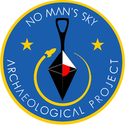Langley_83_Alpha (Gemini Outpost)
Andrew Reinhard, 2019. https://doi.org/10.5284/1056637. How to cite using this DOI
Data copyright © Andrew Reinhard unless otherwise stated
This work is licensed under a Creative Commons Attribution 4.0 International License.
Primary contact
Andrew
Reinhard
No Man's Sky Archaeology
Resource identifiers
- ADS Collection: 3567
- DOI:https://doi.org/10.5284/1056637
- How to cite using this DOI
Introduction

Gemini Outpost on the planet Langley_83_Alpha (the name changed to Molshoy Hutoud in the Atlas Rises cataclysm) was created in the Pathfinder era by player SirDannyMacFinn. What remains is a classic set of ruins, which were abandoned by its creator, creating a textbook site for seeing the aftereffects of a major No Man's Sky software update. Atlas Rises not only buried the settlement under a hillside, but changed the climate and landscape from temperate and green to a hostile, snow-covered wasteland. The base exists in a ruined state, missing key components such as a central base unit, rooms, and connecting ladders and corridors (as evidenced from a 2017 archival photo). Three communication stations remain, one of which was placed by the builder stating that he used to live here but has since relocated to the new Galactic Hub in Hilbert. The landscape itself is glitched, and excavating allowed Andrew Reinhard to view the underbelly of paper-thin, procedurally created ground. Evidence also remains of Atlas Rises being an extinction-level event: Langley used to host 21 species of fauna, but now none remain.
This is the 26th site investigated by Andrew Reinhard as part of the No Man's Sky Archaeological Project, which includes videos, photos, site report, and manifest of communication stations.





